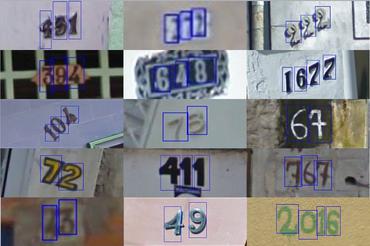Search Results for author: He Wen
Found 15 papers, 5 papers with code
Rasterized Edge Gradients: Handling Discontinuities Differentiably
no code implementations • 3 May 2024 • Stanislav Pidhorskyi, Tomas Simon, Gabriel Schwartz, He Wen, Yaser Sheikh, Jason Saragih
Computing the gradients of a rendering process is paramount for diverse applications in computer vision and graphics.
URHand: Universal Relightable Hands
no code implementations • 10 Jan 2024 • Zhaoxi Chen, Gyeongsik Moon, Kaiwen Guo, Chen Cao, Stanislav Pidhorskyi, Tomas Simon, Rohan Joshi, Yuan Dong, Yichen Xu, Bernardo Pires, He Wen, Lucas Evans, Bo Peng, Julia Buffalini, Autumn Trimble, Kevyn McPhail, Melissa Schoeller, Shoou-I Yu, Javier Romero, Michael Zollhöfer, Yaser Sheikh, Ziwei Liu, Shunsuke Saito
To simplify the personalization process while retaining photorealism, we build a powerful universal relightable prior based on neural relighting from multi-view images of hands captured in a light stage with hundreds of identities.
RDBench: ML Benchmark for Relational Databases
no code implementations • 25 Oct 2023 • Zizhao Zhang, Yi Yang, Lutong Zou, He Wen, Tao Feng, Jiaxuan You
Benefiting from high-quality datasets and standardized evaluation metrics, machine learning (ML) has achieved sustained progress and widespread applications.
Vulnerability Assessment of Industrial Control System with an Improved CVSS
no code implementations • 14 Jun 2023 • He Wen
Cyberattacks on industrial control systems (ICS) have been drawing attention in academia.
The Digital Divide in Process Safety: Quantitative Risk Analysis of Human-AI Collaboration
no code implementations • 29 May 2023 • He Wen
(v)How to quantify the risk of human-AI collaboration in process safety?
Alert of the Second Decision-maker: An Introduction to Human-AI Conflict
no code implementations • 25 May 2023 • He Wen
The collaboration between humans and artificial intelligence (AI) is a significant feature in this digital age.
Garment Avatars: Realistic Cloth Driving using Pattern Registration
no code implementations • 7 Jun 2022 • Oshri Halimi, Fabian Prada, Tuur Stuyck, Donglai Xiang, Timur Bagautdinov, He Wen, Ron Kimmel, Takaaki Shiratori, Chenglei Wu, Yaser Sheikh
Here, we propose an end-to-end pipeline for building drivable representations for clothing.
Rethinking the Data Annotation Process for Multi-view 3D Pose Estimation with Active Learning and Self-Training
1 code implementation • 27 Dec 2021 • Qi Feng, Kun He, He Wen, Cem Keskin, Yuting Ye
Notably, on CMU Panoptic Studio, we are able to reduce the turn-around time by 60% and annotation cost by 80% when compared to the conventional annotation process.
Modeling Clothing as a Separate Layer for an Animatable Human Avatar
no code implementations • 28 Jun 2021 • Donglai Xiang, Fabian Prada, Timur Bagautdinov, Weipeng Xu, Yuan Dong, He Wen, Jessica Hodgins, Chenglei Wu
To address these difficulties, we propose a method to build an animatable clothed body avatar with an explicit representation of the clothing on the upper body from multi-view captured videos.
InterHand2.6M: A Dataset and Baseline for 3D Interacting Hand Pose Estimation from a Single RGB Image
2 code implementations • ECCV 2020 • Gyeongsik Moon, Shoou-I Yu, He Wen, Takaaki Shiratori, Kyoung Mu Lee
Therefore, we firstly propose (1) a large-scale dataset, InterHand2. 6M, and (2) a baseline network, InterNet, for 3D interacting hand pose estimation from a single RGB image.
 Ranked #8 on
3D Interacting Hand Pose Estimation
on InterHand2.6M
Ranked #8 on
3D Interacting Hand Pose Estimation
on InterHand2.6M
Balanced Quantization: An Effective and Efficient Approach to Quantized Neural Networks
no code implementations • 22 Jun 2017 • Shuchang Zhou, Yuzhi Wang, He Wen, Qinyao He, Yuheng Zou
Overall, our method improves the prediction accuracies of QNNs without introducing extra computation during inference, has negligible impact on training speed, and is applicable to both Convolutional Neural Networks and Recurrent Neural Networks.
EAST: An Efficient and Accurate Scene Text Detector
32 code implementations • CVPR 2017 • Xinyu Zhou, Cong Yao, He Wen, Yuzhi Wang, Shuchang Zhou, Weiran He, Jiajun Liang
Previous approaches for scene text detection have already achieved promising performances across various benchmarks.
 Ranked #3 on
Scene Text Detection
on COCO-Text
Ranked #3 on
Scene Text Detection
on COCO-Text
 Curved Text Detection
Curved Text Detection
 Optical Character Recognition (OCR)
+1
Optical Character Recognition (OCR)
+1
Training Bit Fully Convolutional Network for Fast Semantic Segmentation
no code implementations • 1 Dec 2016 • He Wen, Shuchang Zhou, Zhe Liang, Yuxiang Zhang, Dieqiao Feng, Xinyu Zhou, Cong Yao
Fully convolutional neural networks give accurate, per-pixel prediction for input images and have applications like semantic segmentation.
Effective Quantization Methods for Recurrent Neural Networks
2 code implementations • 30 Nov 2016 • Qinyao He, He Wen, Shuchang Zhou, Yuxin Wu, Cong Yao, Xinyu Zhou, Yuheng Zou
In addition, we propose balanced quantization methods for weights to further reduce performance degradation.
DoReFa-Net: Training Low Bitwidth Convolutional Neural Networks with Low Bitwidth Gradients
13 code implementations • 20 Jun 2016 • Shuchang Zhou, Yuxin Wu, Zekun Ni, Xinyu Zhou, He Wen, Yuheng Zou
We propose DoReFa-Net, a method to train convolutional neural networks that have low bitwidth weights and activations using low bitwidth parameter gradients.


